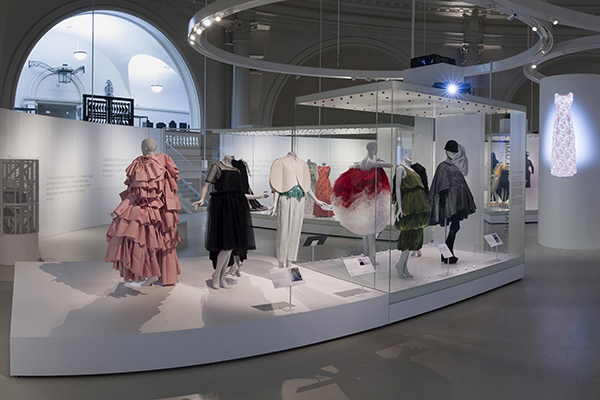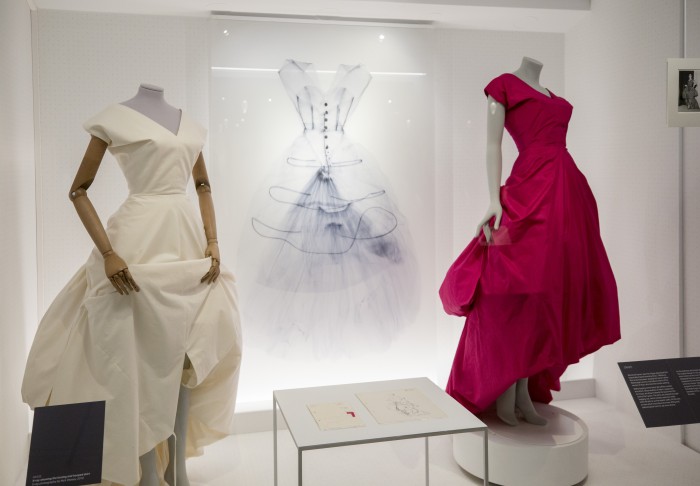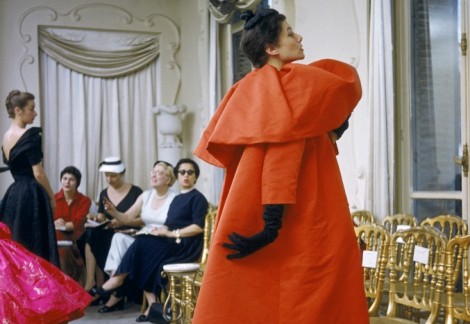Main image: Model wearing Balenciaga orange coat as I. Magnin buyers inspect a dinner outfit in the background, Paris, France, 1954 © Mark Shaw
Last weekend Field Grey paid a visit to the Balenciaga: Shaping Fashion exhibition at the V&A. The exhibition, spread across the fashion wing of the museum, explores the work and legacy of influential Spanish couturier Cristóbal Balenciaga. Dubbed ‘the master of couture’, visitors can admire some of the designers most iconic pieces and gain insight into how the house shaped the industry and remains a source of inspiration to this day.

Highlights of the exhibition include pieces from Balenciaga’s shape-shifting phase in the 1950s, pioneering a radical new wave of ‘semi-fit’ lines, a complete escape from Dior’s hour-glass New Look silhouettes of the same time. His loose, voluminous designs defined a new way to be dress, and to be ‘sexy’.
Here we look at six key topics that the exhibition focusses on, along with some seminal pieces that really caught our eye.

Silk gazar
In this dress Balenciaga’s experimentation with form and fabric leads to a complete abstraction of the body. Made the year before he retired, this collection reasserted his relevance to 1960s fashion. Although a hit with the press, few sold because of its impracticality. One wearer found it almost impossible to go to the bathroom, which comes as no surprise. Balenciaga liked the design and included it in the first retrospective of his work in 1970.
Invisible Engineering
Evening Coat 1950, wool
Some of Balenciaga’s most innovative designs were also the simplest. Here a T-shaped kimono cut is manipulated into dramatic folds by an invisible internal ribbon, which runs the length of the inside sleeves and holds the gathers in place. Vogue described it as having the ‘sculptured, direct beauty of a Roman toga’.

The Unsexy Sack
‘Sack’ Day Dress 1957-8 (above)
‘It’s Hard to be Sexy in a Sack!’ cried the Daily Mirror in 1957. Balenciaga’s ‘sack’ dress shocked when he first presented it in the late 1950s. Its straight line contrasted sharply with the still dominant hourglass shape favoured by his main competitor, Christian Dior. In eradicating the waist altogether, Balenciaga anticipated the popular shift dresses on the 1960s.
The Amphora Line
Evening Dress 1959
A further development of the semi-fitted silhouette, this evening dress is sometimes called ‘The Amphora Line’, referring to the curved shape of Greek vases. The complex shape is formed by two pieces of fabric which join at the centre front and continue around the back to fall in long gathered strips forming a decorative bow.
Perfectionism
Balenciaga was a true craftsman. He was involved in every element of creating a collection and demanded high standards. The smallest mistake might cause a design to be pulled apart and begun again. This pursuit of perfection had a profound impact on this disciple Hubert de Givenchy, who still recalls the emphatic instructions of his mentor. Although the fashion industry has changed pace significantly since Balenciaga’s reign, with some designers producing four or more collections a year, there remain those who aspire to this absolute control and attention to detail in their work.

Cut & Construction
Balenciaga’s training in tailoring set a high standard for his workrooms. He insisted on perfection. Sleeves were an obsession. Balenciaga believed they were fundamental to the perfect fit. When the sleeves were not right, he could be heard shouting in Spanish la manga! (the sleeve), before picking the garment apart and starting again.
The well-cut Balenciaga suit became a staple of many a fashionable woman’s wardrobe. He introduced a looser-fitting ‘easy line’; three-quarter length sleeves and stand-away collar, ideal for displaying a string of pearls. His pared-back designs of the 1960s used innovative pattern-cutting to create garments with few seams.
For more information, visit the V&A website.

Field Grey will be exhibiting at the London Design Fair 21—24 September 2017 at the Old Truman Brewery

